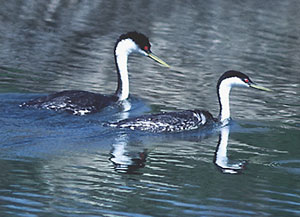Species of Concern: Western Grebe
September 2004
Western Grebes, noted for their striking black and white plumage and dazzling courtship displays, are getting unfortunate attention for their dramatic population decline along the west coast. They are one of several COASST species considered a Species of Concern, the broad title encompassing both state and federal lists of species in trouble.
Species can be “listed” at the federal level as endangered or threatened. A listed species is given special protections on federal land (beyond those given to all migratory birds)—disturbing, harming, or killing individuals is illegal without special permits. However, making it onto the list is an arduous process. It means that extensive research into declining population trends has been conducted and then vetted by the relevant stewardship agency. For birds, that’s the US Fish and Wildlife Service. In many cases, an official listing comes only after catastrophic population declines. There is also a tremendous backlog—more than 200 species are currently candidates for listing at the federal level. Most states also have their own endangered, threatened, and candidate lists, as well as additional listing levels, including the category “sensitive.” The Western Grebe is a State Candidate Species for Listing in Washington.

Western Grebe. (Anonymous)
The largest of our local grebes, Westerns winter along the coast in large flocks from southern British Columbia to central Mexico. During the spring, they migrate to freshwater wetlands where they breed in dense colonies. Grebe nests float (!) and are constructed by the parents out of plentiful aquatic vegetation. After hatching, chicks regularly climb on their parents’ backs to rewarm themselves after exposure to the water. With sinuous necks and long bills, these piscivorous birds are well adapted for spearing small fish such as smelt, perch, and even juvenile salmon.
Since our surveys began in 1998, the Western Grebe has always been in the COASST top 10, cresting at 7% of the total identified carcass count in '01–'02. Unlike some species, such as murres, gulls, and fulmars that are documented frequently because of their relative abundance as live birds, finding Western Grebes on our top 10 list is alarming because the species is in severe decline in Washington, Oregon, and California. Declines of Western Grebes have been documented on their wintering grounds, particularly in the Puget Sound region where the Puget Sound Ambient Monitoring Project (PSAMP) and Washington Sea Grant Program have reported 71–95% declines in abundance indices since the 1990s. Significant nest loss and declines of up to 50% have also been documented at breeding colonies in California, Oregon, and British Columbia.
Why the low numbers? Western Grebes have had their share of interactions with humans. During the late 1800s, declines were the result of avaricious egging and feather hunting, which fell out of fashion by the 1900s. By 1950, significant dieoffs were attributed to pesticides. With the publication of Rachel Carson’s Silent Spring, and the ban on DDT, mortality levels decreased, yet concern is still raised about elevated levels of pesticides and heavy metals in eggs. These days, most studies implicate habitat disturbance and loss as key threats to grebe populations. Unstable water levels (caused by high water use) leave nests high and dry during critical nesting periods. Recreational boating and other human-related disturbances cause parents to flush off eggs and chicks, leaving their young vulnerable to predators.
All told, COASSTers have found 130 Western Grebes, the vast majority from October–March, the post-breeding mortality and winterkill months. Because almost all of them were found on the outer coast, we cannot rule out the possible population effects caused by stressors in wintering habitat as yet another factor affecting this sensitive species. Hopefully, declines in Western Grebe populations can be reversed so that this State Candidate never makes it onto the List.